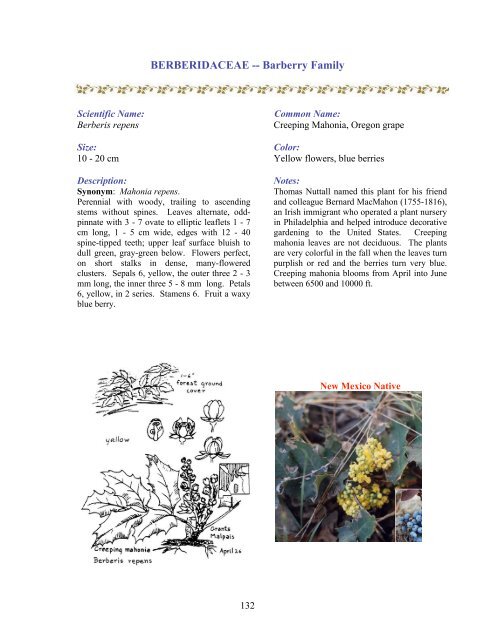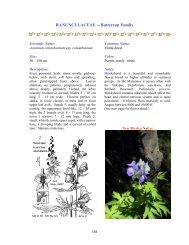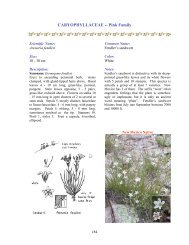BERBERIDACEAE -- Barberry Family - New Mexico Flores
BERBERIDACEAE -- Barberry Family - New Mexico Flores
BERBERIDACEAE -- Barberry Family - New Mexico Flores
Create successful ePaper yourself
Turn your PDF publications into a flip-book with our unique Google optimized e-Paper software.
Scientific Name:<br />
Berberis repens<br />
Size:<br />
10 - 20 cm<br />
<strong>BERBERIDACEAE</strong> -- <strong>Barberry</strong> <strong>Family</strong><br />
Description:<br />
Synonym: Mahonia repens.<br />
Perennial with woody, trailing to ascending<br />
stems without spines. Leaves alternate, oddpinnate<br />
with 3 - 7 ovate to elliptic leaflets 1 - 7<br />
cm long, 1 - 5 cm wide, edges with 12 - 40<br />
spine-tipped teeth; upper leaf surface bluish to<br />
dull green, gray-green below. Flowers perfect,<br />
on short stalks in dense, many-flowered<br />
clusters. Sepals 6, yellow, the outer three 2 - 3<br />
mm long, the inner three 5 - 8 mm long. Petals<br />
6, yellow, in 2 series. Stamens 6. Fruit a waxy<br />
blue berry.<br />
132<br />
Common Name:<br />
Creeping Mahonia, Oregon grape<br />
Color:<br />
Yellow flowers, blue berries<br />
Notes:<br />
Thomas Nuttall named this plant for his friend<br />
and colleague Bernard MacMahon (1755-1816),<br />
an Irish immigrant who operated a plant nursery<br />
in Philadelphia and helped introduce decorative<br />
gardening to the United States. Creeping<br />
mahonia leaves are not deciduous. The plants<br />
are very colorful in the fall when the leaves turn<br />
purplish or red and the berries turn very blue.<br />
Creeping mahonia blooms from April into June<br />
between 6500 and 10000 ft.<br />
<strong>New</strong> <strong>Mexico</strong> Native




